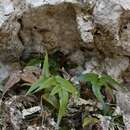Comprehensive Description
provided by North American Flora
Anemia speciosa Presl, Abh. Bohm. Ges. Wiss. V. 4: 349. 1845
Anemia mexicana paucifolia Hook. Second Cent. Ferns/*/. 65. 1861.
Rhizome creeping, thickly clothed with long turgid mainly lightor yellowish-brown hairs ; fronds several, dorsal, distichous, loosely fasciculate, the stipes of the fertile fronds not equaling the sterile fronds. Fertile fronds 10-50 cm, long, rigidly erect ; stipe up to 30 cm. long, usually longer than the sterile lamina, mostly stoutish, dullstramineous or light-brownish from a darker base, nearly terete or lightly canaliculate above, at first noticeably dark-fibrillose especially toward the base, glabrescent; sterile lamina broadly deltoid-ovate, up to 18 cm. long and 15 cm. broad, long-acuminate, once-pinnate, the rachis similar to the stipe, sulcate, deciduously fibrillose ; pinnae 1-4 pairs, approximate or the lower ones slightly apart, spreading or somewhat ascending, equilateral or nearly so, petiolate, the 2 lower pairs about equal, oblong-lanceolate from an obtusely cuneate or roundedtruncate base, in large specimens 6.5-9.5 cm. long and 2-2.5 cm. broad, tapering gradually from near the middle to a long acute apex ; upper pinnae smaller and relatively broader, narrowly ovate-lanceolate, the terminal pinna similar but usually much larger (maximum 9-11.5 cm. long), deltoid-lanceolate, the apex greatly produced; leaf-tissue rigidly coriaceous, thick, bright lustrous green above, paler and very sparingly gla^ndular below, glabrous upon both surfaces ; veins oblique, repeatedly dichotomous, somewhat apart except toward the margin, distinctly impressed upon the upper surface, elevated below, glabrous; margins cartilaginous, usually serrulate, the teeth stoutish, appressed or commonly hamate ; fertile pinnae up to 15 cm. long, usually much shorter, never equaling the sterile lamina, borne 1.5-3 cm. below, ascending, the panicle about twice as long as the slender stalk, flattish, lanceolate in outline, the divisions mostly close, oblique, the lower and middle ones distinctly stalked ; spores widely and sharply striate. Sterile fronds considerably smaller, otherwise similar.
Type locality: Western Mexico. ■ Distribution : Southern and western Mexico to the Departments of Pet^n and AltaVerapaz, Guatemala; Cuba (rare).
- bibliographic citation
- Lucien Marcus Underwood, Ralph Curtiss BenedictWilliam Ralph Maxon. 1909. OPHIOGLOSSALES-FILICALES; OPHIOGLOSSACEAE, MARATTIACEAE, OSMUNDACEAE, CERATOPTERIDACEAE, SCHIZAEACEAE, GLEICHENIACEAE, CYATHEACEAE (pars). North American flora. vol 16(1). New York Botanical Garden, New York, NY
Anemia speciosa: Brief Summary
(
Vietnamese
)
provided by wikipedia VI
Anemia speciosa là một loài dương xỉ trong họ Anemiaceae. Loài này được C. Presl mô tả khoa học đầu tiên năm 1845.
- license
- cc-by-sa-3.0
- copyright
- Wikipedia tác giả và biên tập viên

